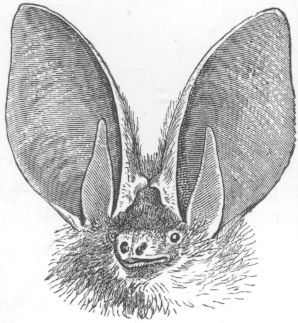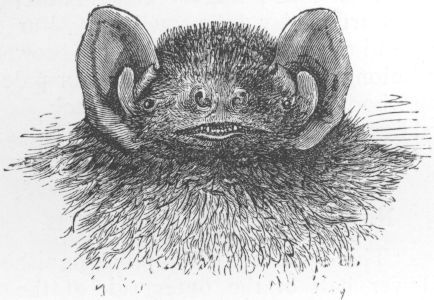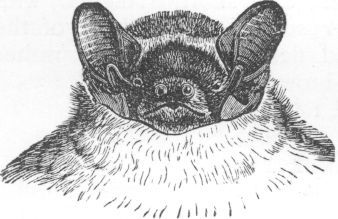| Page 22 | |
|
Natural History of the Mammalia of India and Ceylon - by Robert A. Sterndale F.R.G.S., F.Z.S. (1884) | |
| prev page next page | contents |
SUB-FAMILY VESPERTILIONIDÆ.
These bats have simple nostrils, as in the frugivorous ones, with no complications of foliated cutaneous appendages; the muzzle is conical, moderately long, and clad with fur; the ears wide apart; the inner margins springing from the sides, not the top of the head; the tragi are large; eyes usually very small, and the tail, which is long, is wholly included in the membrane.
Dentition (usually): Inc., 2—2/6; can., 1—1/1—1, premol., 3—3/3—3; mol., 3—3/3—3. The upper incisors are small, and placed in pairs near the canines, leaving a gap in the centre. The lower ones sharp-edged and somewhat notched. At birth there are twenty-two teeth, which are shed, and replaced by others, with sixteen additional ones, the adult bat having thirty-eight teeth.
Ears very large, united at the base; outer margin of the ear conch terminating opposite the base of the tragus, the inner margin with an abrupt rounded projection directed inwards above the base; tragus very large, tapering upwards, with a lobe at the base of the outer margin.
Dentition: Inc., 2—2/6; can., 1—1/1—1; premolars, 2—2/2—2; molars, 3—3/3—3.
The English species P. auritus is very common there, and also in France; its
ears are nearly as long as its body, yet, when reposing, they are so folded as
to be almost out of sight. The Indian species is only a variety distinguishable
by its yet longer ears ("and comparative shortness of the thumbs"—Dobson).

|
| Plecotus auritus |
77. PLECOTUS AURITUS vel HOMOCHROUS.
HABITAT.—The Himalayas and the Khasia Hills.
DESCRIPTION.—Head slightly raised above the face-line; ears nearly as long as the fore-arm, joined by a low band across the forehead at the bases of their inner margins; wings from the base of the toes; feet slender; tip of the tail free; fur silky, short, and of a uniform dull brown.
SIZE.—Head and body, 1·7 inch; ears, 1·55 (ears of English type of same size, 1·4 inch); tail, 1·7 inch. Jerdon gives larger results, but I put more reliance on Dobson's figures.
Bats with very broad and obtuse muzzles; the glandular prominences much developed between the eyes and the nostrils; crown of the head flat; but what distinguishes it from the following genus, Scotophilus, is the presence of four incisors in the upper jaw, whereas Scotophilus has two only—otherwise the two genera are very similar.
78. VESPERUGO NOCTULA.
HABITAT.—Nepal.
 .
.
Vesperugo noctula
DESCRIPTION.—Head broad and flat; ears oval and broad; the outer margin convex, reflected backwards, and forming a thick lobe terminating close to the angle of the mouth; tragus short and curved inwards; muzzle devoid of hair; fur dark reddish brown.
79. VESPERUGO LEUCOTIS.
HABITAT.—Deserts of Northern India, and Beluchistan.
DESCRIPTION.—"Ears, sides of face, about the eyes, interfemoral membrane, antehumeral membrane, and that portion of the wing membrane along the sides of the body, white, very translucent; remaining portion of wing membrane sepia, traversed by very distinct reticulations; fur on the upper surface black at the base of the hairs for about half their length, remaining portion light yellowish brown; beneath the same, but paler, almost white."—Dobson.
80. VESPERUGO MAURUS.
HABITAT.—Khasya Hills.
DESCRIPTION.—Muzzle broad and flat, with large labial development; ears broad, triangular, broadly rounded off above; tragus broad and square; fur long and dense, uniformly sooty brown, with greyish tips; membranes, nose, ears and lips black.
SIZE.—Head and body 1-1/10 inch; tail, 1 inch.
81. VESPERUGO AFFINIS.
HABITAT.—Burmah (Bhamo, Yunan).
DESCRIPTION (apud Dobson).—Head flat; upper labial glands so developed as to cause a deep depression between them on the face behind the nostrils; ears broad as long from behind; the outer margin extends from the tip to its termination near the corner of the mouth without emargination or lobe; tragus broad; inner margin straight; outer convex; small triangular lobe at base. Fur chocolate brown above, lighter on head and neck; beneath dark brown with lighter tips on the pubes, and along the thighs dirty white or pale buff.
SIZE.—Head and body, 1·9 inch; tail, 1·65 inch.
There is a good figure of the head of this bat in Dobson's Monograph; it was obtained by Dr. J. Anderson at an elevation of 4500 feet at Bhamo.
82. VESPERUGO PACHYOTIS.
DESCRIPTION.—"This species is readily distinguished by the peculiar thickness of the lower half of the outer side of the ear-conch, which appears as it were excavated out of the thick integument of the neck; tragus short, curved inwards."—Dobson.
This bat is more fully described with three illustrations in Dobson's Monograph; he does not mention where it is found, so it may or it may not be an Indian species.
83. VESPERUGO ATRATUS. Syn.—NYCTICEJUS ATRATUS.
HABITAT.—Darjeeling.
DESCRIPTION.—Head broad; muzzle obtuse; upper labial glands largely developed; ears large, oval, with rounded tips, which in the natural position of the ears appear acute, owing to the longitudinal folding of the outer side of the conch on the inner, commencing at and almost bisecting the tip (Dobson). Fur long, dense and black; Jerdon says rich dark brown; paler beneath.
SIZE.—Head and body, 1·9 inch; tail, 1·8 inch.
84. VESPERUGO TICKELLI.
HABITAT.—Chybassa, Jashpur, and Sirguja.
DESCRIPTION.—Head broad and flat; labial glands developed; ears moderate, rounded above; outer edge straight, emarginate opposite base of tragus, terminating in a small lobe; tragus lunate; tail long; last vertebra free. The face is more clad with fur than in other species of this genus; fur of the body pale, straw brown above, pale buff beneath. For a fuller description and illustration, see Dobson's Monograph.
SIZE.—Head and body, 1·65 inch; tail, 2 inches.
85. VESPERUGO PACHYPUS.
HABITAT.—Darjeeling, Tenasserim, and Andaman Islands.
DESCRIPTION.—Crown of head very flat; ears short, triangular, with broadly rounded tips, tragus short; under surface of the base of the thumb and soles of the feet with broad fleshy pads; wings rather short; fur fine and dense, above reddish brown, paler beneath.
SIZE.—Head and body, 1·75 inch; tail 1 inch.
86. VESPERUGO ANNECTANS.
HABITAT.—Naga Hills and Assam.
DESCRIPTION.—Muzzle sharper; face hairy; ears pointed; tragus long; colour dark brown; illustration in Dobson's Monograph.
SIZE.—About 2 inches; tail, 1·6 inch.
Unites the appearance of a Vespertilio to the dentition of Vesperugo.
87. VESPERUGO DORMERI.
HABITAT.—Southern India and Bellary Hills.
DESCRIPTION.—Head flat; ears shorter, triangular, with rounded tips; tragus with a small triangular lobe near base of outer margin; fur brown, with ashy tips above, darker brown below, with the terminal third of the hairs white. Dentition approaches the next genus, there being only one pair of unicuspidate upper incisors placed, one by each upper canine.
88. (VESPERUGO) SCOTOPHILUS SEROTINUS. Syn.—VESPERUGO SEROTINUS., The Silky Bat (Jerdon's No. 35).
HABITAT.—Europe, but extending through Asia to the Himalayas, Beluchistan and Kashmir.
DESCRIPTION.—Ears shorter than head, widely separate, ovate, angular, projecting forward, terminating in a convex; lobe ending on a level with the corner of the mouth; tragus twice the length of its breadth, semi-cordate; fur deep bay or chestnut brown; above fulvous, grey beneath; hairs of back long and silky, but the colour of the fur varies considerably.
SIZE.—Head and body, 2½ inches; tail, 2; wing expanse, 13.
This is a rare bat in India, though Captain Hutton has procured it at Mussoorie. In England it is not uncommon even near London; it flies steadily and rather slow, and is found in ruins, roofs of churches, and sometimes old hollow trees.
89. (VESPERUGO) SCOTOPHILUS LEISLERI. Syn.—VESPERUGO LEISLERI., The Hairy-armed Bat (Jerdon's No. 36).
HABITAT.—Himalayas.
 .
.
Vesperugo Leisleri.
DESCRIPTION.—Ears short, oval, triangular; tragus short, rounded at tip; membrane attached to base of outer toe; all toes short; membrane over the arms very hairy, some cross-lines of hair on the interfemoral membrane; fur long, deep fuscous brown at base, chestnut at the tip; beneath greyish brown.—Jerdon.
SIZE.—Head and body, 2¼ inches; tail, 3¾; expanse, 11½.
SCOTOPHILUS PACHYOMUS.
(Jerdon's No. 37)
Synonymous with his No. 35; see Dobson's Monograph.
90. (VESPERUGO) SCOTOPHILUS COROMANDELIANUS. Syn.—VESPERUGO ABRAMUS;
VESPERTILIO COROMANDELICUS., The Coromandel Bat
HABITAT.—India generally, Burmah and Ceylon.
DESCRIPTION.—Ears triangular, rather large; outer margin straight or slightly concave; tragus lunate; feet small; wing membrane attached to the base of the toes; fur short, above dingy brown, the hairs tipped with a lighter tinge, paler beneath.
SIZE.—2½ inches, including tail, which is about 1-1/8; wing expanse, 7½.
This is a very common little bat, akin to the English Pipistrelle, and is found everywhere in roofs, hollow bamboos, &c.
91. (VESPERUGO) SCOTOPHILUS LOBATUS. Syn.—VESPERUGO KUHLII., The Lobe-eared Bat (Jerdon's No. 39).
HABITAT.—India generally.
DESCRIPTION.—Ears small, triangular; the base of the margin very convex forward; a triangular lobule above the base of the outer margin; tragus short and uniform in width; a short muzzle; wings from the base of the toes; feet small; calcaneum long; tip of tail free; fur blackish yellow above, ashy beneath.
SIZE.—Two and a-half inches, of which the tail is 1¼; expanse 7-2/3. Jerdon, quoting Tomes, states that this is the same as V. Abramus, but that is the synonym of the last species.
